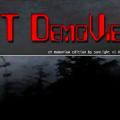Search the Community
Showing results for tags 'linux'.
-
I have some very old demos from 2003 and 2004 that I would love to watch, but I have never been able to figure out how and fear it may be impossible. The files end in a .dm_83 extension, and all of my current demos end in .dm_84. From my own research it appears you must run the same version of ET and the mod that created it, but I really don't know much more than that. I tried renaming them to .dm_84 which caused them to show up in the list of replays, but they failed to play with the following error demoMsglen > MAX_MSGLEN I figured if anyone would know how to watch these, it would be the big brains here on FA. Thanks!
- 11 replies
-
- 2
-

-
ET W:ET installation on a 64BIT Linux Debian stable operating system
nUllSkillZ posted a topic in ET Discussion
The post describes the steps to install W:ET (32Bit) on a 64BIT Linux Debian stable (current: 11) operating system. In preparation of the W:ET installation (as "su"): apt update -y apt upgrade -y dpkg -–add-architecture i386 apt-get install -y libc6:i386 apt-get install lib32z1 Installation of W:ET (installation program found on the Splashdamage Homepage) as "su": ./et260b.x86_keygen_V03.run The two following pakets had to be installed on my PC because W:ET didn't start and showed error messages (as "su"): apt install libsdl1.2debian:i386 apt install libgl1:i386 If there are sound problems one could try the following script (not sure where I found it) (not sure if "su" is necessary): ./et-sdl-sound In the script there is the option for alsa or pulse (# is a comment symbol): # SDL audio driver #SDL_AUDIODRIVER="alsa" SDL_AUDIODRIVER="pulse" Remarks: The pakets might be named different on other linux distributions or Debian versions. The scripts / programs might have to be made executable with (.run as "su"): chmod +x et260b.x86_keygen_V03.run chmod +x et-sdl-sound -
File Name: ET DemoView Edition File Submitter: SunLight File Submitted: 11 Mar 2012 File Category: Software ET DemoView Edition by SunLight This is an alternative ET version with some extra features for demo reviewing. I made it at first because on Linux I couldn't use image-et to rewind demos, later I compiled it for Windows too, because I liked the new features, and I wanted to use it instead of image-et, which is a great tool but more movie-making oriented The main purpose of this modified version is to check possible cheaters demos, but you might like such features as demo unlagging, movement graph, watching demos from other players p.o.v., attacker view, even for reasons other than cheater busting. Changelog: 1.0 - added sdl sound support for Linux, no need for et-sdl-sound anymore - disabled alt + enter on Linux, it was annoying for me, sorry... (you can still set r_fullscreen 1 and /vid_restart) - blocked /connect command, this game version is only for demo review! - demo unlagger, to see real players aim without delay - improved r_shownormals with new modes, to check for wallhackers more easily - 'real view' of player aim without screenshakes (can be enabled or disabled) - you can toggle shownormals, real aim view, and player names with your keyboard - demo seek/rewind (beta! there could be bugs, but it's mostly working) - demos are now sorted in alphabetical order in et main menu 1.1 - added a command to show player names - you can watch demos from another player's point of view (beta) - attacker view, to automatically follow all players who attack the player who recorded the demo - added a 'movement graph' to check for warp in player movement 1.2 - bug fixes and new seek algorithm (fixes warmup bug, and it's faster) - added more infos in the hud - custom fov and zoom - pause / timescale 0 support - 2 alternative timescales 1.3 - fixed skipping when watching 'laggy' demos - added a new key bind ('A') for automatic unlag and shownormals, based on the player you are currently watching - fixed a bug in the hud with low resolution r_mode 1.4 - Alternative demo auto-unlagger. It interpolates players in a way similar to antilag. You can still use the old (manual) one - Fixed Silent mod crash when watching demos from other players point of view - Improved player names visuals, now you can also see only team mates or enemies - Fixed Goldrush and Adlernest map bug, when watching in slow motion - Player body in r_shownormals 6 or 7 now looks like r_showtris - Linux version has less dependencies see readme.htm inside the zip for more infos Click here to download this file
- 70 replies
-
- 24
-

-

-
Hello, I have a small problem with installation on Linux mint. When I run the installation on the terminal, It asks for the etkey the first thing and here is the problem. I can't pass that section by choosing any option available or by getting an etkey from etkey.org. If I choose the option of "no etkey required" which is the one more likely to work, The prompt then asks for the root password, when I enter the password, the terminal crashes. Could you please help me with it?
-
I'm looking for some recommendations or maybe feedback from people who used iGPU without dGPU. The laptop wouldn't be for gaming (et does not count ) but mainly for processing large amounts of data (25 million+ json documents in mongodb database), frequent rebuilds of node applications and automated testing framework on top of all that. Average ram usage 15Gb(not counting swap pages) but I'm leaning towards 32Gb to be safe from the system locks. System Linux duh with a tiling window manager for increased efficiency. Best picks I found are: Lenovo ThinkPad T580 (20L90024PB5P32) due to its mobility and endurance and I think it's the most reasonable one for how I intend to use this laptop. Lenovo ThinkPad X1 Extreme (20MF000WPB2PP32) due to dGPU for media creation. Dell XPS 15 9570 due to battery and performance. Been reading a lot of topics, Reddit, etc and still can't decide. Based on feedback from reading it's like a lottery with laptops. It's true that those laptops have their issues (low build quality for some models, coil whine, backlight bleed, some keys on the keyboard) that's why asking for more feedback maybe? No limit on the money since it's work machine so efficiency matters. If you are unable to find which configurations I picked for thinkpads, let me know and I'll list the parts for both. Thanks Edit: Thinkpad T580 configuration: CPU: Intel I7-8550U 1,8Ghz-4Ghz iGPU: Provided by CPU Intel UHD 620 Display: 1080p 15,6" Storage: Nvme 512Gb RAM: 32768Mb DDR4 Modem WWAN module 4G Battery build in 4cell + 3cell external ThinkPad X1 extreme configuration: CPU: Intel I7-8750H 2,2Ghz dGPU: Nvidia Geforce GTX 1050 TI 4Gb Display: 1080p 15,6" Storage: Nvme 2x 256Gb - probably in RAID 1 RAM: 32768Gb DDR4 Battery: built in 80WH
-
Version 1.4
3252 downloads
ET DemoView Edition by SunLight This is an alternative ET version with some extra features for demo reviewing. I made it at first because on Linux I couldn't use image-et to rewind demos, later I compiled it for Windows too, because I liked the new features, and I wanted to use it instead of image-et, which is a great tool but more movie-making oriented The main purpose of this modified version is to check possible cheaters demos, but you might like such features as demo unlagging, movement graph, watching demos from other players p.o.v., attacker view, even for reasons other than cheater busting. Changelog: 1.0 - added sdl sound support for Linux, no need for et-sdl-sound anymore - disabled alt + enter on Linux, it was annoying for me, sorry... (you can still set r_fullscreen 1 and /vid_restart) - blocked /connect command, this game version is only for demo review! - demo unlagger, to see real players aim without delay - improved r_shownormals with new modes, to check for wallhackers more easily - 'real view' of player aim without screenshakes (can be enabled or disabled) - you can toggle shownormals, real aim view, and player names with your keyboard - demo seek/rewind (beta! there could be bugs, but it's mostly working) - demos are now sorted in alphabetical order in et main menu 1.1 - added a command to show player names - you can watch demos from another player's point of view (beta) - attacker view, to automatically follow all players who attack the player who recorded the demo - added a 'movement graph' to check for warp in player movement 1.2 - bug fixes and new seek algorithm (fixes warmup bug, and it's faster) - added more infos in the hud - custom fov and zoom - pause / timescale 0 support - 2 alternative timescales 1.3 - fixed skipping when watching 'laggy' demos - added a new key bind ('A') for automatic unlag and shownormals, based on the player you are currently watching - fixed a bug in the hud with low resolution r_mode 1.4 - Alternative demo auto-unlagger. It interpolates players in a way similar to antilag. You can still use the old (manual) one - Fixed Silent mod crash when watching demos from other players point of view - Improved player names visuals, now you can also see only team mates or enemies - Fixed Goldrush and Adlernest map bug, when watching in slow motion - Player body in r_shownormals 6 or 7 now looks like r_showtris - Linux version has less dependencies see readme.htm inside the zip for more infos -
Finally have a working poller + api that polls for a specified "service" with one of three methods. cURL - Will try to receive a web page and upon failure, send an outage notice to the API which sends an email to the specified email address (me) and inserts an outage into the MySQL database. Local - Checks to see if a service is running with ps -aux command. (same thing if fail) Ping - Uses ping (ICMP) to check if host is up. (same thing if fail) The poller is written in C++ and the API in php 7.0 using sendmail for the emails, each service has an associated key that is used when reactivating the service for polling and is sent to the user in the outage email. (outage email format) And everything can be manipulated while the poller is running via invoking the poller binary with the appropriate arguments required for making a new outage or telling the poller that a service is back online
-
Hey everyone: Been focusing on tweaking and setting up ET to run on Linux. 1.) Back in 2012 had it running great on Debian, just wondering how many others out there run Linux, and what flavor? 2.) I.E. Redhat, Mint, PCLinuxos, Fedora, Debian, Ubuntu, OpenSuSe etc... 3.) And why do you use the Distro that you do? Ease of friendly GUI like windows? Compatible with your drivers and system Video processor? would love to hear from some of you. I run Kali a lot from a different laptop but this is geared toward different endeavors more along the lines of learning more advanced tasks. Currently I'm in windows but this will change 2 weeks after I finish working out compatibility issues, and move my guid number. Thx, just curious Soup
-
Up until a few years ago, I ran Ubuntu as a dual boot with Windows, but found I was getting dissatisfied with Ubuntu so I removed it and went on with life. Now that I reformatted and reinstalled Win 10, I want to go back to a Linux Dual boot. I have 2 500 GB HDD's, C: and D: drives, and the D: drive is freshly split in half, giving me 225 GB for Linux. Keep in mind I'm still pretty novice to Linux and probably forgot half of what I knew, what do you Linux pros think I should go with, excluding Ubuntu? Keep in mind I'm not going to be developing Android Kernels, lol, but I still want a lot of functionality in a Linux environment to learn more advanced things. Plus I'm one that likes to be able to do a lot of customizing. I know Mint is the first thing that most people think of but maybe not the best Distro for a guy like me that just wants to cross over and still be able to fully function in a Linux environment. (of course, Mint MAY be the best for me) I've been seeing ElementaryOS is gaining a lot of popularity, for example. Also, which Desktop Environments you like best?? KDE is a great one, but MATE Plasma is looking nice, too So hook a noob up with some ideas, please
-
Hello. I'm trying to install a Linux Distro in my new PC, I've installed first Win10 x64(because the USB 3.0 couldn't install Win7), I've read a lot about UEFI BIOS protection, but I can't really find the way to disable it into my Mobo Gigabyte H110M, and can't find a way to make it work, I've searched alot on forums or google, so, if any of you guys know how, please tell me, I'm kinda desperate. Thanks in advance.
-
File Name: ET 2.60b PATCH ( ALL OS ) File Submitter: SvK2701 File Submitted: 16 Oct 2015 File Category: Software Note : Tested on W:ET 2.60 Setup - Windows 10 (32 bit) Note : Tested on W:ET 2.60 Setup - Windows 8.1 (32 bit) Note : Tested on W:ET 2.60 Setup - Windows 7 [ Home Edition /Ultimate /Professional ] (32 bit) Note : Tested on W:ET 2.60 Setup - Windows XP [ Professional ] (32 bit) Note : Tested on W:ET 2.60 Setup - Linux ( Ubuntu ) (64 bit) About : This File will transform your ET 2.60 Setup To ET 2.60b without losing Anything ! Procedure : Download "Enemy Territory 2.60b patch" and Extract it. After that Open the Folder and Open Linux for Linux Users / MacOSx for MacOS Users / win32 for Windows Users. For Windows Users : Copy and Paste "ET" and "ETDED" in your Game Root Folder. When it says Replace press Yes For Linux Users : Copy and Paste "ET.x86" and "ETDED.x86" in your Game Root Folder. For MacOS Users : Copy Everything Under "Wolfenstein ET.app" and Past in your Game Root Folder. When it says Replace press Yes Click here to download this file
-
Hello everyone, I'm working on a script that helps to post some notifications on forums. The goal is to have a script that takes a local file and posts it with some information on FA forum. I have a login / password / forum post but i struggle a bit to find a clean solution. I'm not very experienced in PHP and wanted to ask if someone can give me some tips how to program it.
-
...hi all im playing on mac and im connecting to et with "playonmac" (base is wine prog) all other emulators didn't work proper i had big lags, et legacy is not an opinion for me. so for now i can connect via playonmac and can play silent, jaymod and no quarter. the big issue is i cannot play etpro. anyone found a proper way to get this working? i heard its also not possible for linux users via "wine". so if someone has a good idea or found a way to get this working, im very thankful. Cheers Saskia
-
Not too long ago I wiped Windows 10 off my HDD and installed SteamOS in its place. I am trying to setup Wine so I can run Windows compat. software on Linux. I am not to knowledgeable with compiling packages/sources on Linux. Is anyone familiar with Wine? Could anyone attempt to help me install it? I have tried to follow the instructions on WineHQ two times... neither time was successful.. Thanks in advance! Also, base system: SteamOS GNU/Linux 2.0 (brewmaster) 64-bit
-
So for the last few weeks, I've been getting random freezes with my mouse (Logitech mx500). I've tried moving USB ports, and that has not helped. I also tried killing Synergy, but that didn't help either. Given that the mouse is 4 years old, it's probably just dying. I have another Logitech, a Performance MX wireless, that works fine...but the MX performance and the g500 are different in that the g500 has onboard memory to save key bindings. For example, I have the left thumb button assigned to "c", and the right thumb button assigned to "x". Then in ET, I have "c" assigned to one toggle script, and x assigned to another toggle script. I set those bindings in Windows with my kids computer, and when I move the g500 to my gamin rig, the settings are still saved. The MX performance, however, does not save those settings. I tried using xbindkeys to set the wireless mouse buttons, and that works fine in the terminal - but when playing ET, it does not work. Not sure why. Based on Zero's suggestion, I tried going into the controls menu and seeing what ET thought those buttons actually represented, and turns out both thumb buttons register as KP_Equals. That rules out being able to bind around the issue through ET. My thinking right now is to go with this mouse: https://www.amazon.com/dp/B010U57G1K/ref=pd_lpo_sbs_dp_ss_1?pf_rd_p=1944687602&pf_rd_s=lpo-top-stripe-1&pf_rd_t=201&pf_rd_i=B00MSOIUOO&pf_rd_m=ATVPDKIKX0DER&pf_rd_r=2SF5768TBKVXDY85Q0WD since roccat offers a Linux software package to set it up. Zero had suggested this mouse here: https://www.dreammachines.io/products/dm1-pro-s-optical-gaming-mouse-3360-sensor but I fear I'll run into the same issue as I did with my wireless mouse. I'm open to feedback and/or suggestions.
-
Anyone have experience in apache and munin? How do you configure htaccess so that munin reads the pass and then reads the data from mod_status? Don't give me links from Google search. I can google as well but if someone have hands on experience on it, let me know. Thanks
-
File Name: Amx Mod X For Linux and Windows File Submitter: SvK2701 File Submitted: 16 Oct 2015 File Category: Software Amxmodx For Linux and Windows Linux Amxmodx Version : 1.8.1 Windows Amxmodx Version : 1.8.2 Amxmodx With all Modules Present, Supported By : Counter Srtike 1.6 Counter Strike Condition Zero Counter Strike Source Counter Strike Global Offensive ** Tested In Windows XP | 7 ( ALL VERSION ) | 8 / 8.1 | 10 | Server ** Tested In Linux CentOS 5 / 6 / 7 | Debian | Ubuntu ** Note : To Make Amxmodx work you must have Metamod/ Metamod Source Installed Click here to download this file
-
Okay, so here is the deal.. I am trying to install Mint on a separate hard drive in my pc. I went through the instilation easy as can be, restarted the pc and boom, booted windows, and the drive I put Mint on was not visible anymore in windows. Went through a few steps, got the HDD back (While losing all info on that drive) but still Mint-less.. Now I know what some of you are saying, "Why not run it from a flash drive or something?", but I want to rid myself of windows, I want Mint to be my only operating system.. Anyone who knows their way around this OS, your help would be much appreciated.... (For some reason Heretic, I am thinking you have the plan) hehehe.. Thanks in advance
- 13 replies
-
- mint
- fresh install
-
(and 1 more)
Tagged with:
-
Installing Ubuntu This section will show you how to download and install Ubuntu and give you a brief introduction to that popular Operating System. This tutorial deals with Ubuntu 10.04 Lucid Lynx but will most likely work with every following version as well. It will guide you through the intuitive installation using an ordinary USB flash disk with at least 1GB of disk space. There's also a way to install it without using a CD/DVD or a USB flash disk, but this way you'll produce a universal Linux flash disk which could be used to install Ubuntu on any PC or as Recovery-CD to retrieve data from a broken system. Downloading Ubuntu The first thing you obviously need to do to install Ubuntu on your system is downloading an installation image of it. Therefore, head over to Ubuntu.com and download the 32-bit version of Ubuntu. Hint: The main Ubuntu mirrors are usually pretty busy. Sweden's mirror is currently one of the fastest in Europe. Creating a Ubuntu USB flash drive Attach a regular USB flash drive with at least 1GB of disk space to your PC. Since the data on the flash drive will be erased during that step, I'd recommend backing up your data, using an old flash drive or buy a new one. (They are only about 10$ and you could use it for whatever you want afterwards.) Now open a command line with administrative rights by opening your Start menu, typing in cmd and right click the first entry to Run as administrator. Enter the following commands. (Note that X equals the Disk # from list disk.) Having your bootable flash drive ready, extract the Ubuntu image's content to your flash drive using WinRar or any other program which is able to extract .iso files. Hint: For more detailed instructions on how to create a bootable flash drive, have a look at this tutorial. Image: http://fearless-assa...=images&img=610 Installing Ubuntu Reboot your PC and make sure you selected to boot from a USB flash drive. (The key to select this option is mostly F12 or ESC, please refer to your Mainboard's documentation for further information on this.) As soon as the purple screen with the accessibility icon on the bottom appears, hit the Enter key and select the language of your choice. Navigate to Install Ubuntu to start the installation routine. The first three steps are self-explanatory and will guide you through the basic settings. When it comes to disk space preparation, select Install them side by side, choosing between them each startup and continue. Enter your login credentials, decide whether to import your documents from your Windows partition and start the installation process. This may take a while, depending on your computer's performance. Reboot your PC and remove the USB flash disk when asked to. You will be presented with Linux' bootloader, GRUB. As you might have already expected, you could either boot into your new Ubuntu installation by choosing Ubuntu, with Linux 2.6.32-21-generic (Version number depending on the installed kernel.) or into your old Windows by choosing Windows 7 (loader) (on /dev/sda1). Image: Configuring Ubuntu To prevent any security leaks, we are going to change the password of Ubuntu's Administrator account, called root. To do so, open a new Terminal window by navigating to Applications – Accessories – Terminal. Type in sudo passwd, enter your user's password, enter a new password for root and confirm it. I recommend updating the system regularly, which could be either done graphically or via Terminal. Since I prefer the latter way, run the following command to update the application list, update the applications themselves and upgrade the system's core, called kernel: To install drivers needed to run Enemy Territory smoothly, go to System – Administration – Hardware Drivers, let it update it's lists and follow the on-screen instructions to installed the drivers. Installing Enemy Territory This section will show you how to download and install the game itself, updating PunkBuster, fixing potential sound problems and finally how to uninstall it. Note: To install Enemy Territory on a 64-bit system, you need to have ia32-libs installed. Feel free to contact me for further details. Downloading and Installing Enemy Territory The Linux version of Enemy Territory consists of the the game in version 2.60 of about 260MB and a linux update of about 8MB. To download both from a fast mirror, run the following commands in Ubuntu's Terminal application: Following the usual process, we install the game first by running sudo sh et-linux-2.60.x86.run. If you didn't run into any problems yet, you will be prompted with a semi-graphical installation routine. Accept the license agreements, leave the installation path at it's default value /usr/local/games/enemy-territory, the symlink path at /usr/local/bin and leave both options, Enemy Territory and PunkBuster client/server files, checked to make sure it installs PunkBuster as well. Accept PunkBuster's license agreement and install the startup menu entries. To prevent security problems, please do not start the game from the installer's prompt because it will run it as root, being able to make changes on your system without notifying you. Repeat the same procedure to install the patch: Execute it with sudo sh et-linux-2.60-update.x86.run, accept the license agreements, leave the paths on their default values and you're done. Hint: To clean up the Terminal window, just type in clear and hit the Enter key. Image: Updating PunkBuster It's time to get an up-to-date version of PunkBuster to avoid getting banned from your favorite servers. To download the updates, visit PunkBuster's pbsetup.run website, pass the Captcha and download the file. Since the file will be downloaded to your user account's Downloads folder, move it to the desktop for your comfort. You could easily access the Downloads folder by navigating to Places – Downloads. Extract the ZIP-File by right clicking on it and selecting Extract Here. Run the following commands from your Terminal window to update PunkBuster: Image: Fixing Downloads and Sound Run the game once to create the required folder structure by navigating to Applications - Other - enemy-territory. Execute sudo chown -R fa:fa ~/.etwolf/ (where fa:fa equals your user account) to be able to download any custom soundpacks or maps later. To be able to hear your enemy in-game we need to fix potential sound problems by running sudo apt-get install esound. If you've still got sound problems, run sudo apt-get install vim to install a great text editor, executing sudo vim /etc/init.d/etSoundFix.sh, pressing the i key to enter vim's Insert mode, entering echo “et.x86 0 0 direct†> /proc/asound/card0/pcm0p/oss and pressing ESC followed by :wq to save the file and leave vim. The only thing left to do is setting the correct permissions by running sudo chmod +x /etc/init.d/etSoundFix.sh and adding it to our startup daemon by executing sudo update-rc.d etSoundFix.sh defaults. (Don't worry about the warnings at this point, it just grumbling that we didn't include any LSB information to our file.) Uninstalling Enemy Territory Unfortunately there is no uninstallation routine included in Enemy Territory's installer, so you'll have to uninstall it manually by doing:
-
Hey there, In the past, I've used various linux distributions such as BackTrack/Kali, BlackArch, ArchAssult, Fedora Security, etc. to run penetration tests and other shady things without an issue. But in particular I've been using the aircrack suite for probably close to 4-5 years now and I have yet to run into this problem. So here's the skinny: I got a ThinkPad obsession back in January, and just not too long ago, a Lenovo TP T60 (Type 2007) was gifted to me, and because the number of jobs that I have had lately requiring forensics tools, pen testing, etc, I was needing a dedicated mobile machine for such purposes. So it came to me with Windows XP and the recovery (Lenovo R+R) partition was all in Chinese... so I formatted that garbage off, and I got into booting various live environments to see what worked best for me. Kali Linux: Nogo. Too commercial/branding in your face. Wireless did not work (could only monitor) OOTB. Fedora 21: Nogo. Goddamit anaconda, can't you work for a change? Crunchbang almost worked for me... As did Blackarch. And so I tried out Manjaro with LXDE. Now on Kali, blackarch and crunchbang, the aircrack suite worked perfectly. But the reason why I mention these different distros is for a reason. Kali's (Debian) wireless interface came up as wlan0. Crunchbang (arch): wlan0. Blackarch (...):wls3. Manjaro: (arch): wls3. So I'm guessing that is because of the integration of systemd, or driver differences (ipl3945 firmware loaded vs not loaded). So what I did was I added the blackarch repository to Manjaro after using my google-fu, and discovering that other people have done so (I still wish I came up with the idea first). After some newbie fiddling around with pacman, I got some tools installed from the blackarch repo, and I proceeded to run them: airmon-ng start wls3 -> works just fine. Sometimes if I've stopped it during the same user session, I have to run it twice to get it to generate a mon1, as mon0 gives me error to start airmon. The next command, airodump-ng mon1 generates-> "ioctl(SIOCSIFFLAGS) failed: Name not unique on network". And this is where I reside stuck at the moment. I did some googling and edited my hosts file based on something that worked for two people: # # /etc/hosts: static lookup table for host names # #<ip-address> <hostname.domain.org> <hostname> 127.0.0.1 paradigm ::1 localhost.localdomain localhost # End of file Where paradigm (the name of my computer) replaces the localhost.localdomain entry- thus pointing the loopback at the correct "network". I'm thinking I'm missing something here though... hosts files have never been my cup of tea. Any and all help is appreciated! Here is output of lspci: 00:00.0 Host bridge: Intel Corporation Mobile 945GM/PM/GMS, 943/940GML and 945GT Express Memory Controller Hub (rev 03) 00:01.0 PCI bridge: Intel Corporation Mobile 945GM/PM/GMS, 943/940GML and 945GT Express PCI Express Root Port (rev 03) 00:1b.0 Audio device: Intel Corporation NM10/ICH7 Family High Definition Audio Controller (rev 02) 00:1c.0 PCI bridge: Intel Corporation NM10/ICH7 Family PCI Express Port 1 (rev 02) 00:1c.1 PCI bridge: Intel Corporation NM10/ICH7 Family PCI Express Port 2 (rev 02) 00:1c.2 PCI bridge: Intel Corporation NM10/ICH7 Family PCI Express Port 3 (rev 02) 00:1c.3 PCI bridge: Intel Corporation NM10/ICH7 Family PCI Express Port 4 (rev 02) 00:1d.0 USB controller: Intel Corporation NM10/ICH7 Family USB UHCI Controller #1 (rev 02) 00:1d.1 USB controller: Intel Corporation NM10/ICH7 Family USB UHCI Controller #2 (rev 02) 00:1d.2 USB controller: Intel Corporation NM10/ICH7 Family USB UHCI Controller #3 (rev 02) 00:1d.3 USB controller: Intel Corporation NM10/ICH7 Family USB UHCI Controller #4 (rev 02) 00:1d.7 USB controller: Intel Corporation NM10/ICH7 Family USB2 EHCI Controller (rev 02) 00:1e.0 PCI bridge: Intel Corporation 82801 Mobile PCI Bridge (rev e2) 00:1f.0 ISA bridge: Intel Corporation 82801GBM (ICH7-M) LPC Interface Bridge (rev 02) 00:1f.1 IDE interface: Intel Corporation 82801G (ICH7 Family) IDE Controller (rev 02) 00:1f.2 SATA controller: Intel Corporation 82801GBM/GHM (ICH7-M Family) SATA Controller [AHCI mode] (rev 02) 00:1f.3 SMBus: Intel Corporation NM10/ICH7 Family SMBus Controller (rev 02) 01:00.0 VGA compatible controller: Advanced Micro Devices, Inc. [AMD/ATI] RV515/M52 [Mobility Radeon X1300] 02:00.0 Ethernet controller: Intel Corporation 82573L Gigabit Ethernet Controller 03:00.0 Network controller: Intel Corporation PRO/Wireless 3945ABG [Golan] Network Connection (rev 02) 15:00.0 CardBus bridge: Texas Instruments PCI1510 PC card Cardbus Controller Thanks again
-
I've decided to put good use to the MicroSD card slot that lie embedded in my Surface Pro 2, and use it to hold some virtual disk files. I've always loved toying around with virtual machines, and to this day I never use just one computer. I currently have 4 that I could use at any time... Anyways, here is Manjaro Openbox running in Hyper-V on a live CD. It is currently installing, and then I'll get to tinker around
-
I was thinking about putting Ubuntu over Windows 8. I just don't know if my ET files would be affected. I was thinking about saving them on Dropbox, or a external usb flash drive, and then transferring it back onto the newly installed Linux. I don't know If i would have to install ET 2.60b for linux though in order for it to run. Anybody have any suggestions on how to approach this so I don't lose my ET files, but still have it run on Ubuntu 14.04? NEVERMIND GUYS I GOT IT
-
Hi, I used to use windows 8 on my PC, but due to different reasons, now i dont. I am now running windows 7 Ultimate, but my wifi driver will not work. My question is, which FREE OS can i install on my PC, and then run ET on? Here are my basic needs, Unity 3d, Gimp, Wolf ET, and Xfire. I have run Ubuntu 13.10 on my PC, and the wifi does work on linux. My PC specs: 4Gb ram 320GB hdd E1 amd cpu crappy graphics card Thanks in advance for the help! Regrads, Thomas BTW I am fully prepared to use the new OS (linux based i assume) as my only OS. I have dual booted before, but im done with that.
-
Hi there. Few weeks ago I decided to leave Win and now I'm trying to use Linux. Found a Zorin OS version which makes it bit easier but after installing ET I had no sound. After many tries I tried http://community.linuxmint.com/tutorial/view/1071 which works for me.
-
Hi guys. Well, I have installed ubuntu in my sister netbook, but the processor isnt compatible with the Distro, so I-ve decided return to windows, but the GRUB doesnt stop appear everytime I turn on the netbook, I need restore the mbr partition, my DD format is NTFS. What can I do? Thanks in advance.
About Us
We are glad you decided to stop by our website and servers. At Fearless Assassins Gaming Community (=F|A=) we strive to bring you the best gaming experience possible. With helpful admins, custom maps and good server regulars your gaming experience should be grand! We love to have fun by playing online games especially W:ET, Call of Duty Series, Counter Strike: Series, Minecraft, Insurgency, DOI, Sandstorm, RUST, Team Fortress Series & Battlefield Series and if you like to do same then join us! Here, you can make worldwide friends while enjoying the game. Anyone from any race and country speaking any language can join our Discord and gaming servers. We have clan members from US, Canada, Europe, Sri Lanka, India, Japan, Australia, Brazil, UK, Austria, Poland, Finland, Turkey, Russia, Germany and many other countries. It doesn't matter how much good you are in the game or how much good English you speak. We believe in making new friends from all over the world. If you want to have fun and want to make new friends join up our gaming servers and our VoIP servers any day and at any time. At =F|A= we are all players first and then admins when someone needs our help or support on server.






















